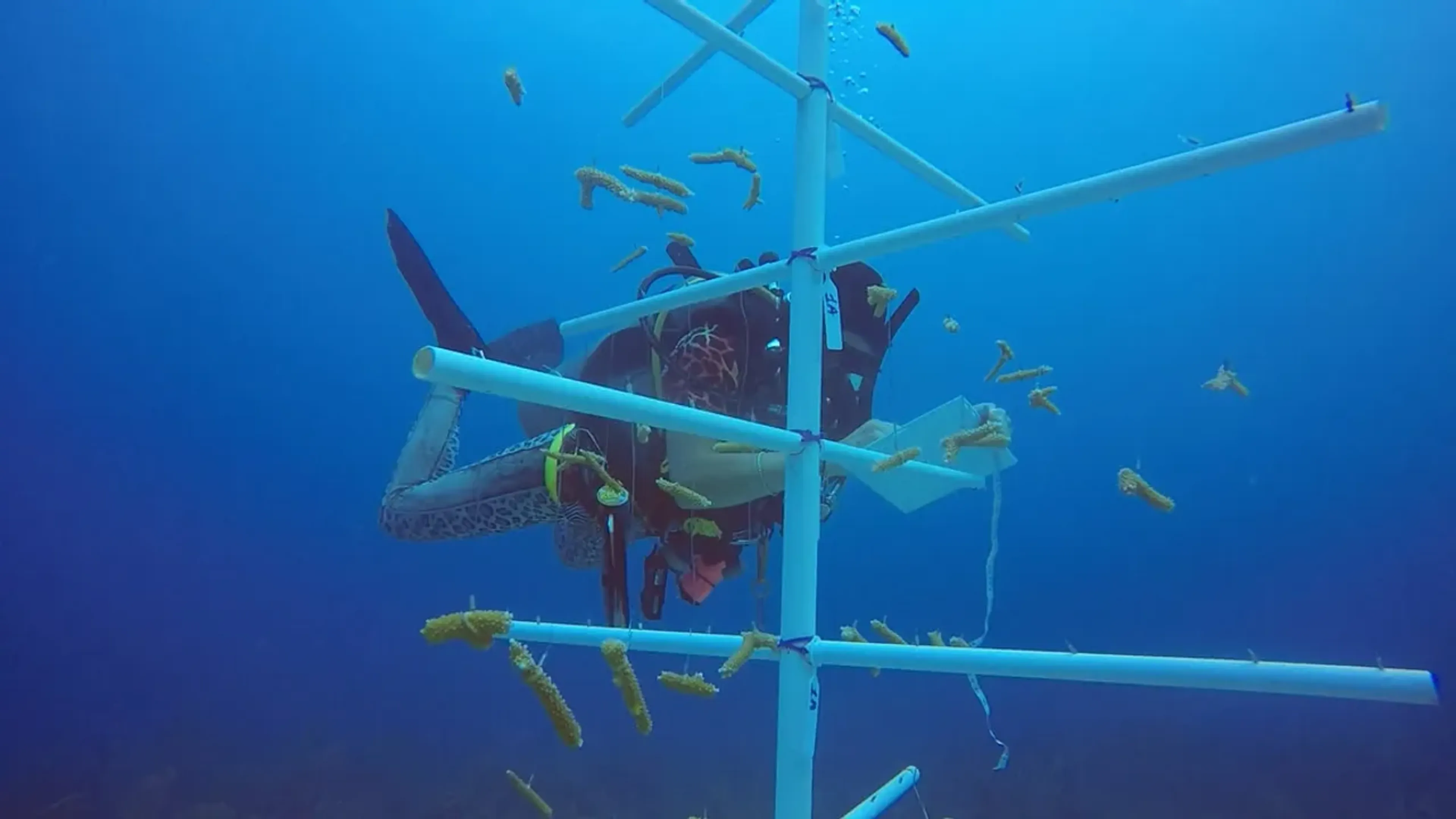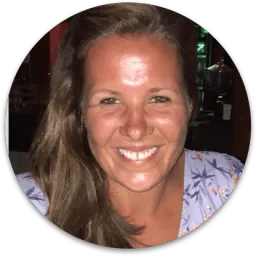Claire Mogford
• 9 min read
Coral reef degradation has been much publicised in the past couple of years but I didn’t really understand what this meant until I started the Divemaster programme at Utila Dive Centre (UDC).
It was here that I learned that coral reefs are actually made up of tiny living organisms, known as polyps, that secrete calcium carbonate. It is this substance that ‘builds’ the coral reef. If the polyps get stressed (for example by warmer water temperatures or other factors, such as pollution by toxic ingredients in sunscreen) they expel the algae that provides 90% of their energy.
It’s the algae that gives these corals their distinctive colour so when it’s expelled the coral starts to look white, hence why the process is known as coral bleaching. Without the algae the polyps gradually starve to death and leave behind only the calcium carbonate structure that they once sat in. This structure then begins to deteriorate and the reef starts to disintegrate. Coral reefs are critically important to our ecosystems and for keen divers, like myself, they’re also one of the main reasons why we choose to visit the underwater world again and again.
In response to worldwide concerns of coral bleaching, there are a number of projects are underway in an effort to reverse the destruction and help regenerate coral reefs. One such project, the Utila Coral Restoration Project, is a recent effort aimed at doing just that: restoring coral. Located in the Caribbean, off the coast of Honduras, Utila is a small island with a thriving tourism industry. While diving there, I took the opportunity to interview two key figures behind the Utila Coral Restoration project: Jemma Aitken and Dani Mejia. I asked them a few questions to learn more about it.
What is the Utila Coral Restoration Project?
The Utila Coral Restoration Project is designed to help restore the critically endangered populations of staghorn and elkhorn corals. Fragments of these corals are collected and then grown in a coral nursery, with the aim of replanting them on the reef once they are large enough to be self-sustainable.
picture: fragments
How did the project come about?
It started as a way of getting ahead of issues seen in other places where the reef has degraded to basically nothing. It’s a preventative measure rather than a reactive one and is about trying to get one step ahead of the problem.
Why are coral reefs so important?
Coral reefs support 25% of marine life by providing habitat and shelter and are also the basis of a food chain that provides for millions of humans. They protect coastlines from erosion caused by waves or storms, and are also important in maintaining a nice surface temperature (they absorb heat and CO2 from the atmosphere)
They’re also very important to the diving and tourism industry. Here in Utila, 90% of the economy comes from dive tourism so if the reefs suffer we will have major problems.
Who is involved?
The project is a co-operation between Utila Dive Centre (UDC) and Kanahau (a conservation research facility that promotes research into the flora and fauna of Utila) and has the also has the backing of the ICF (the organisation tasked with protecting Honduran wildlife) and Honduran Marina Mercante.
UDC is represented by us (Jemma Aitken and Daniela Mejia) and Kanahau is represented by Andrea Martinez, a founding member and director of the organisation (who is also a PADI and SSI dive instructor).
How does the coral nursery work?
In order for the corals to grow, we have to create an environment that eliminates competition, predators and stress. The first stage is to collect fragments of healthy coral that have naturally become detached from the reef. We then secure them to tree-like structures and look after them by cleaning them weekly to remove algae, sediment and other predators as well as monitoring their growth. We measure not just their length but also their thickness.
picture: survey
The aim is to create larger segments of coral to form a colony that we can successfully reattach to the reef close to where they were collected from. We’ll find a non-sandy hard substrate and will clean the rock before attaching the fragments using a marine epoxy which should secure them in place long enough for the polyps to grow over and create their own binding.
How long does the growth process take?
Based on other similar projects, it should take around six months for the fragments to become large enough to plant back onto the reefs. We’ve looked at projects on our neighbouring island of Roatan and also ones run by the Coral Restoration Foundation and they have seen good results within this timeframe but it will depend on how stress-free we manage to make the environment.
What's the general status of the restoration project?
It took us two and a half years just to get to a stage of being able to start the project, but now all of the necessary permits have been received we’ve able to get things moving pretty quickly. We’ve made three collections of coral so far and have fully populated the three trees that we have.
We’re maintaining them weekly and are seeing faster progress than we expected. The corals are growing over the plastic that holds them and the raw ends (where they’d broken off) are being covered in polyps which means they’re growing and expanding. We’re hopeful that we’ll be able to do our first replanting within the six-month timeframe.
What are the goals for the next year?
We’re currently at full capacity on our three trees but the permit allows us to have up to twenty, so we’d like to plant more of them so we can continue to grow the nursery.
Hopefully in a few months our first fragments will be ready to plant back on the reef and then we’ll be able to start the process again and eventually, if it’s all successful, we’d like to expand to other endangered coral species.
picture: trees
Tell me more about the trees in the coral nursery? Is it not a risk to the ocean using a plastic structure?
The current tree structure is 100% PVC. We have to use plastic as it’s the only thing that can resist the marine environment. Metal and concrete surfaces accumulate more algae so are harder to clean. The trees are secured to the bottom by weights and also have a float to keep them upright and allow some flexibility of movement in bad sea conditions.
We’re currently looking at replacing the branches of the trees with fibre glass as it can hold more weight and also wouldn’t be hollow (we’re finding the algae grows inside at present).
How is the project funded?
So far it’s been completely funded by donations - we’ve applied for some government grants but haven’t received anything yet.
We’ve set a crowd funding target of $3000 for the first stage and have raised over $2,000 so far. In addition to the crowd funding we’re also selling jewelry made by a Honduran designer with all proceeds going to the project.
Each tree costs over $200 though so we need to raise much more if we’re going to get anywhere near our twenty tree capacity.
What does the money go towards?
Most of the money is spent on the trees and materials needed for the maintenance and surveys.
We’d also like to use some of the money to train locals how to dive so that they can learn about the project and spread the word on how important reefs are. Our aim is to train 5-10 people per year and UDC are supporting this.
How can people help?
People can donate via our fundraising page and can also help spread the word about the project.
More generally though people can consider their use of plastics, sunscreens etc as all of these factors have contributed to the issues that our reefs are currently facing.
And if people want to learn more about reef conservation?
They should come to Utila and do the GoEco programme as they can then get involved in the project and develop a better appreciation of marine life. We’re also in the middle of writing a PADI distinctive specialty that will focus on the coral nursery and will be delivered here at UDC.
Thanks very much for your time Jemma & Dani and good luck with the project! For further information on the project or to get involved please contact Jemma and Dani at utilacoral@gmail.com
Biographies
picture: jemma
Jemma Aitken
Jemma is the Resident Marine Biologist at UDC and the creator of the GoEco programme; a 4-week training in marine species identification, coral conditions and marine monitoring. The Little Mermaid inspired a love of the underwater world in Jemma from a young age and she decided to undertake university studies in Marine Biology followed by a MSc in Marine Environmental Management. After her formal training was over she decided that the best way to teach people about marine conservation was through teaching them to dive. She started as a Divemaster and worked her way up to PADI Staff Instructor, before taking on the Marine Biologist role at UDC, where she’s been since 2014.
picture: dani
Daniela Mejia
Daniela also helps deliver GoEco at UDC and leads the coral related component of the programme. She has been diving since 2006 and worked her way up through the instructor levels to that of PADI Staff Instructor. She studied Economics at University and is currently studying for a Masters in Marine Sciences and Management of Marine Protected Areas. She has self-taught and researched quite extensively when it comes to Coral Biology and Research methods and is also certified in AGRRA survey methodologies.
picture: claire
Claire Mogford
Claire is the face behind One Girl and Her Pack, a travel blog that she created to document her round the world travels. Whilst traveling she rediscovered a love of scuba after a 10 year break from the sport. After completing her tune-up she was lucky to get the opportunity to dive some of the world’s top spots, as well as qualifying as a PADI Divemaster at UDC on the island of Utila in Honduras. Her best dive experience to-date has been a liveaboard in the Komodo Islands and now she’s finished her travels she's saving up for a trip to Raja Ampat!


